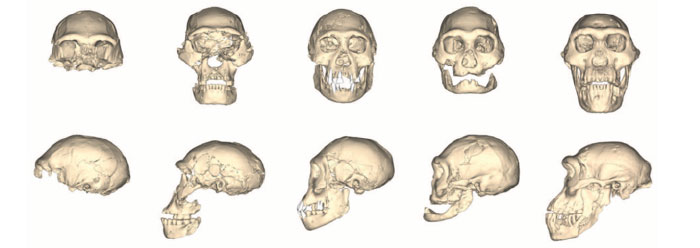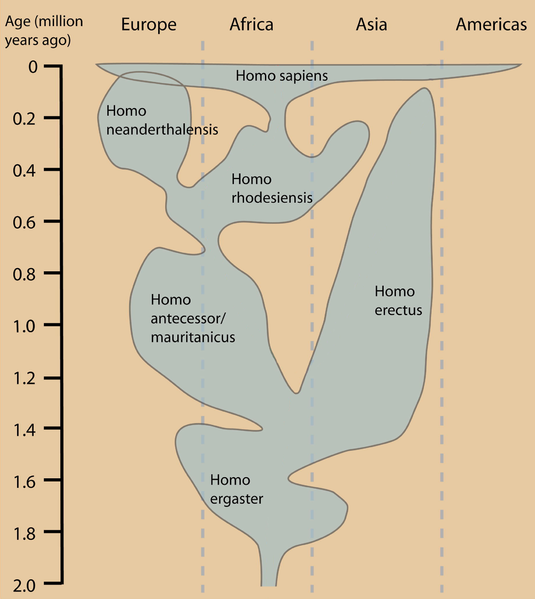Skip to comments.
Human-like Fossil Menagerie Stuns Scientists (article)
Institute for Creation Research ^
| Nov. 8, 2013
| Brian Thomas, M.S., & Frank Sherwin, M.A.
Posted on 11/08/2013 10:07:54 AM PST by fishtank
Human-like Fossil Menagerie Stuns Scientists
by Brian Thomas, M.S., & Frank Sherwin, M.A. *
An international team of scientists made a stunning and controversial discovery from an archaeological site in Dmanisi, a small town in the country of Georgia, that is forcing some scientists to unlearn everything they knew about the story of human evolution. The results from the find appeared in an October issue of the journal Science.1
Among other human skeleton bones, the researchers found five skulls or partial skulls. Some of them looked human, though they were smaller than today's average skull size. But the biggest surprise was that, though these human skulls all had very different shapes, they were buried together within a short time.
Yale University anthropologist Andrew Hill, who was not involved in the discovery, told the Wall Street Journal, "'It gives you a chance to look at variation for the first time.'"2 Instead of showing different transitional human forms living at different times and leading up to modern humans, the fossilized remains at this site showed variation occurring at the same time. Assuming the remains were all human, as the Science authors did, these results end up "drastically simplifying the story of human evolution," according to the WSJ.2
That means, among other things, Homo erectus can no longer be considered an ancestor who lived long before and gave rise to "early Homo" peoples, since the new evidence showed H. erectus, H. rudolfensis, and H. habilis clumped together. "Analysis of the skull and other remains at Dmanisi suggests that scientists have been too ready to name separate species of human ancestors in Africa. Many of those species may now have to be wiped from the textbooks," according to The Guardian.3
Among those species would be Neandertal and Cro-Magnon, which deserve no recognition as separate forms that supposedly evolved into Homo sapiens—modern humans.4 They were uniquely formed people living at the same time as modern-looking people. Australopithecus is also out of the evolutionary line up, now that evolutionists have finally followed its fossil evidence to where creation scientists did long ago when they concluded that it was just an extinct ape and had clearly never evolved into humans.5 Without these key players, the popular pageant of human evolution truly should all be wiped from the textbooks.
If the Dmanisi fossils represent ancient humans, then they show that generations of experts in human evolution have spent effort, time, and research dollars arranging fossil fragments of human skulls into an evolutionary line of descent that never really existed. Perhaps it is time to rethink the whole story.
References
Lordkipanidze, D. et al. A Complete Skull from Dmanisi, Georgia, and the Evolutionary Biology of Early Homo. Science. 342 (6156): 326-331.
Hotz, R. L. Skull Suggests Single Human Species Emerged From Africa, Not Several. The Wall Street Journal. Posted on wsj.com October 17, 2013, accessed October 29, 2013.
Sample, I. Skull of Homo erectus throws story of human evolution into disarray. The Guardian. Posted on theguardian.com October 17, 2013, accessed October 23, 2013.
Thomas, B. Neandertals Mixed with Humans in China. Creation Science Update. Posted on icr.org November 3, 2010, accessed November 4, 2013.
Gish, D. 1975. Man...Apes...Australopithecines...Each Uniquely Different. Acts & Facts. 4 (9).
Image credit: Copyright © 2013 AAAS. Adapted for use in accordance with federal copyright (fair use doctrine) law. Usage by ICR does not imply endorsement of copyright holders.
* Mr. Thomas is Science Writer and Mr. Sherwin is Research Associate, Senior Lecturer, and Science Writer at the Institute for Creation Research.
Article posted on November 8, 2013.
TOPICS: News/Current Events
KEYWORDS: belongsinreligion; creation; dmanisi; evolution; georgia; homoerectus; homoerectusgeorgicus; humanfossils; notanewstopic; origin; origins; republicofgeorgia

Image credit: Copyright © 2013 AAAS. Adapted for use in accordance with federal copyright (fair use doctrine) law. Usage by ICR does not imply endorsement of copyright holders.

Fig. 2 The Dmanisi paleodeme. CT-based visualizations, from left to right: D2280 (skull 1), D2282/D211 (skull 2), D2700/D2735 (skull 3), D3444/D3900 (skull 4), D4500/D2600 (skull 5). Scale bar, 5 cm. See fig. S3 for a full set of standard views.
http://www.sciencemag.org/content/342/6156/326.full
1
posted on
11/08/2013 10:07:54 AM PST
by
fishtank
To: fishtank
Scientists’ beebers stuned!
2
posted on
11/08/2013 10:09:56 AM PST
by
Jack Hydrazine
(IÂ’m not a Republican, I'm a Conservative! Pubbies haven't been conservative since before T.R.)
To: fishtank
significant variation still occurs...


3
posted on
11/08/2013 10:17:13 AM PST
by
DannyTN
To: fishtank
If anthropologists are just now considering what level of variation is likely to occur in prehistoric populations, given that we have 4 billion examples alive today, then their work is no better than that of the average “climate scientist”.
To: fishtank
Fossil MenagerieMcCain and McConnell
5
posted on
11/08/2013 10:20:59 AM PST
by
lonestar
(It takes a village of idiots to elect a village idiot.)
To: William Tell
If anthropologists are just now considering what level of variation is likely to occur in prehistoric populations, given that we have 4 billion examples alive today, then their work is no better than that of the average “climate scientist”. <./i> ... < golf clap > ...
6
posted on
11/08/2013 10:31:59 AM PST
by
dartuser
it’s fun to make fun of evolutionists
it’s fun to make fun of creationists
To: All
8
posted on
11/08/2013 10:38:46 AM PST
by
musicman
(Until I see the REAL Long Form Vault BC, he's just "PRES__ENT" Obama = Without "ID")
To: fishtank
Those ole ape wars must have been legendary, at least to the apes.
9
posted on
11/08/2013 11:13:07 AM PST
by
justa-hairyape
(The user name is sarcastic. Although at times it may not appear that way.)
To: William Tell
4 billion Six billion. Plus.
To: fishtank
One of the specimens is believed to be homodemocraticus, an extremely small-brained ancestor of the modern day homoliberalis.
11
posted on
11/08/2013 11:16:36 AM PST
by
2nd Amendment
(Proud member of the 48% . . giver not a taker)
To: FateAmenableToChange
FateAmenableToChange said:
"Six billion. Plus." I guess I should get out more.
To: fishtank
Forcing facts to fit your moneyed theory is how scientific consensus is emplaced.
13
posted on
11/08/2013 11:52:27 AM PST
by
fella
("As it was before Noah so shall it be again,")
To: fishtank
Wow, the one in the upper right is wearing sunglasses!
To: musicman
Creepy.


15
posted on
11/08/2013 12:54:52 PM PST
by
Rodamala
To: Right Wing Assault
White-rimmed hipster douchebag sunglasses to go with his Starbucks 10th Anniversary Pumpkin Spiked Latte (or as they call it “PSL”).
16
posted on
11/08/2013 12:56:44 PM PST
by
Rodamala
To: fishtank
from the article:
" 'Analysis of the skull and other remains at Dmanisi suggests that scientists have been too ready to name separate species of human ancestors in Africa.
Many of those species may now have to be wiped from the textbooks,' according to The Guardian.3 " The word "species" is just one scientific classification, based on various criteria.
Among animals, different individuals may belong to the same breed, sub-species, species, genus, family, order, etc., etc.
Which classifications they belong to is a matter of definitions and features.
The word "species" generally means no normal interbreeding with members of other species.
Thus, although Polar Bears and Brown Bears can interbreed, they normally do not, and so are classified as separate species.
But if interbreeding is found to be common, then they are considered sub-species of the same species.
So with human ancestors and other pre-humans.
Frequent interbreeding means they are sub-species, little or no interbreeding means they are separate species or even genera.
Here is the current general understanding of human ancestors and other pre-humans:

from the article: "Among those species would be Neandertal and Cro-Magnon, which deserve no recognition as separate forms that supposedly evolved into Homo sapiens—modern humans."
In fact, there is no evidence -- zero -- that Cro-Magnons were anything other than biologically modern humans.
As for Neanderthals, the question is: were they a separate species or just sub-species of human beings?
17
posted on
11/09/2013 4:44:49 PM PST
by
BroJoeK
(a little historical perspective....)
To: lonestar
Snicker snicker guffaw guffaw.
18
posted on
11/26/2013 4:10:23 PM PST
by
Ray76
Disclaimer:
Opinions posted on Free Republic are those of the individual
posters and do not necessarily represent the opinion of Free Republic or its
management. All materials posted herein are protected by copyright law and the
exemption for fair use of copyrighted works.
FreeRepublic.com is powered by software copyright 2000-2008 John Robinson







